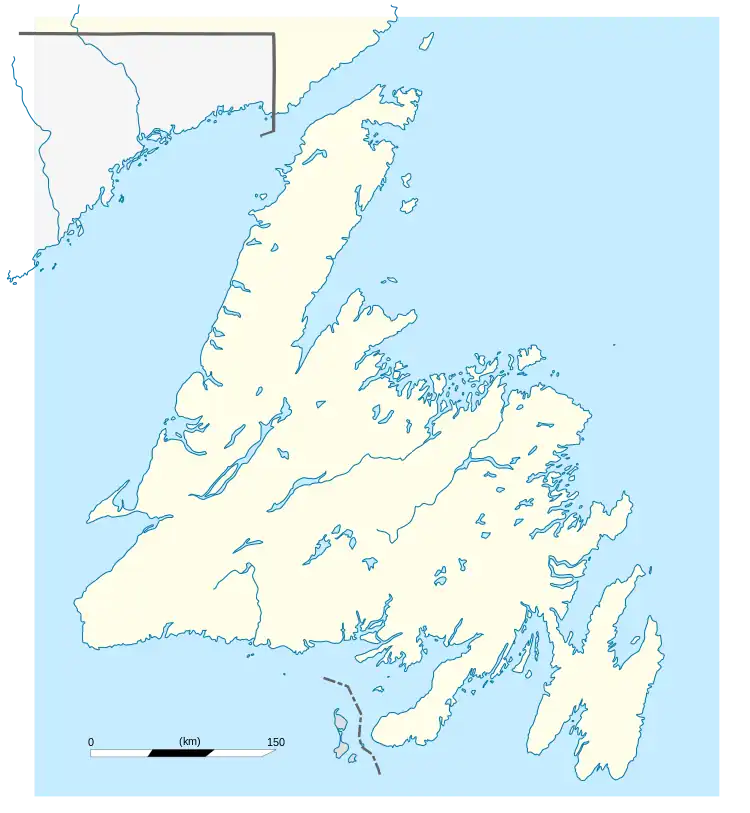Burnt Islands, Newfoundland and Labrador
Burnt Islands is a small coastal community found in God Bay on the southwest coast of Newfoundland, Canada.
Burnt Islands | |
|---|---|
Town | |
.jpg.webp) Burnt Islands aerial view | |
 Burnt Islands Location of Burnt Islands in Newfoundland | |
| Coordinates: 47°35′50.40″N 58°53′07.84″W | |
| Country | Canada |
| Province | |
| Government | |
| • Mayor | Paul Strickland[1] |
| Area | |
| • Land | 9.52 km2 (3.68 sq mi) |
| Population (2021) | |
| • Total | 540 |
| • Density | 65.3/km2 (169/sq mi) |
| Time zone | UTC-3:30 (Newfoundland Time) |
| • Summer (DST) | UTC-2:30 (Newfoundland Daylight) |
| Area code | 709 |
| Highways | |
| Website | http://www.burntislandsnl.ca/ |
| Colombier Islands Lighthouse | |
| Constructed | 1929 (fog alarm) |
| Foundation | concrete base |
| Construction | aluminium skeletal tower |
| Height | 11 m (36 ft) |
| Shape | quadrangular skeletal tower with balcony and lantern[3][4] |
| Power source | solar power |
| Operator | Canadian Coast Guard |
| Fog signal | 1 blast every 30s. |
| First lit | 1971 (current tower) |
| Focal height | 18 m (59 ft) |
| Range | 15 nmi (28 km; 17 mi) |
| Characteristic | Fl W 5s |
Geography
The community is 27 kilometres (17 mi) east from Port-aux-Basques. This community consists of an "island" section and a "main" section that were connected by a causeway in 1969. The community is built on the rocky, barren coastline of the harbour. The countryside consists largely of bogs and marshes with many species of plant and animal life native to Newfoundland being present.
History
Burnt Islands, like many Newfoundland coastal communities, developed around the fishery. The sheltered harbour and proximity to rich fishing grounds were the principal factors in attracting early fishermen to this area between 1839 and 1841. The first recorded settlers settled on what is locally known as the "Main" in 1839, while families settled the "Island" in 1841.
Throughout the late 19th century and well into the 20th century the community continued to thrive with many business firms establishing in the area providing goods, services and employment for people in the area. The community supported a lumber and glue industry at one time.
In 1968 the first fish processing plant was started by Eric King fisheries, employing a large number of the towns residents and continuing to do so to the present day. Also it was in 1969 that the two main areas of settlement were linked together by a causeway, making it the community of Burnt Islands.
In 1991, Alan Handel Productions and the National Film Board of Canada produced the documentary A Passage from Burnt Islands, about education and literacy in this community.
Climate
The climate for Burnt Islands is a maritime climate which consists of fairly cool weather in the summer and somewhat mild temperatures in the winter caused by the moderating effects of the nearby ocean. This area of the southwest coast is well known for its infamous winds that sometimes gust over 150 km per hour.
Demographics
In the 2021 Census of Population conducted by Statistics Canada, Burnt Islands had a population of 540 living in 235 of its 251 total private dwellings, a change of -13.2% from its 2016 population of 622.[2] With a land area of 9.48 km2 (3.66 sq mi), it had a population density of 57.0/km2 (147.5/sq mi) in 2021.[6]
Transportation
The community is linked to the Trans Canada Highway by route 470 at Port aux Basques. From Port aux Basques, known as the Gateway to Newfoundland, Burnt Islands is linked by the Marine Atlantic ferries to Nova Scotia and mainland Canada.
See also
References
- "BURNT ISLANDS". municipalnl.ca. 26 July 2016.
- "Census Profile, 2016 Census: Burnt Islands, Town [Census subdivision], Newfoundland and Labrador". Statistics Canada. 8 February 2017. Retrieved October 24, 2019.
- Rowlett, Russ. "Lighthouses of Canada: Southwestern Newfoundland". The Lighthouse Directory. University of North Carolina at Chapel Hill. Retrieved 2017-02-12.
- List of Lights, Pub. 110: Greenland, The East Coasts of North and South America (Excluding Continental U.S.A. Except the East Coast of Florida) and the West Indies (PDF). List of Lights. United States National Geospatial-Intelligence Agency. 2016.
- "2006 Community Profiles: Burnt Islands, NL". Statistics Canada. 13 March 2007. Retrieved October 24, 2019.
- "Population and dwelling counts: Canada, provinces and territories, census divisions and census subdivisions (municipalities), Newfoundland and Labrador". Statistics Canada. February 9, 2022. Retrieved March 15, 2022.